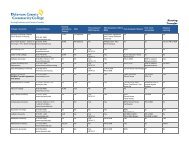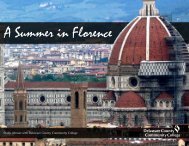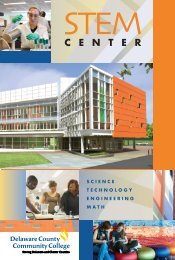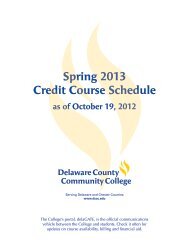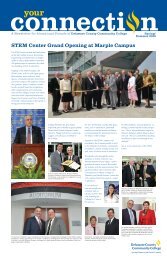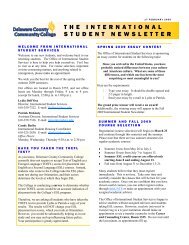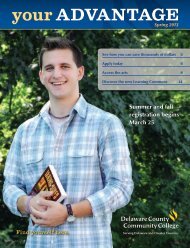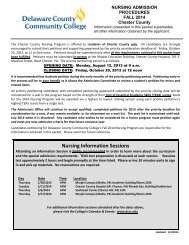2010 Catalog - Delaware County Community College
2010 Catalog - Delaware County Community College
2010 Catalog - Delaware County Community College
You also want an ePaper? Increase the reach of your titles
YUMPU automatically turns print PDFs into web optimized ePapers that Google loves.
COURSE DESCRIPTIONS 85<br />
• Select appropriate light frame, residential construction<br />
material and assemblies in response to a schematic<br />
architectural design.<br />
• Solve design development problems, given a<br />
preliminary design concept, involving issues of space<br />
function and layout, construction detail and aesthetics.<br />
• Prepare graphic documentation, using computer<br />
assisted drafting, to communicate a residential design<br />
concept to the contractor.<br />
Prereq. TCS 100 Coreq. TCC 122<br />
3 Credits 2 Weekly Lecture Hours<br />
2 Weekly Laboratory Hours<br />
ARC 215<br />
Architectural Design Concepts<br />
This course presents fundamentals of the architectural<br />
design process and the graphic techniques, both manual<br />
sketching and CADD, for creating and presenting design<br />
ideas including a review of the types of problems and<br />
concerns that characterize design decisions. The course<br />
emphasizes the need to conceive and manipulate<br />
architecture as space.<br />
Architectural programming is introduced along with<br />
conceptual diagramming techniques and development of<br />
preliminary plans. Design projects develop the ability to<br />
organize space in two- and three-dimensional contexts.<br />
Selected technical topics such as stairway design, complex<br />
roof intersections and egress requirements may be<br />
introduced.<br />
Upon successful completion of this course, students<br />
should be able to:<br />
• Select and manipulate, manually and with CADD,<br />
various drawing types that are used in analyzing and<br />
creating design solutions.<br />
• Recognize and characterize spatial elements and concepts.<br />
• Develop and utilize a set of space definitions and an<br />
architectural program.<br />
• Analyze and document site opportunities and constraints.<br />
• Develop a preliminary design concept from an<br />
organizational diagram.<br />
• Complete a design development from a<br />
preliminary concept.<br />
• Calculate or apply standard design performance measures.<br />
Prereq. ARC 121<br />
3 Credits 2 Weekly Lecture Hours<br />
2 Weekly Laboratory Hours<br />
ARC 221<br />
Architectural Graphics II<br />
An advanced-level course in the graphic documentation<br />
of construction concepts using manual sketching and<br />
CADD techniques. Emphasis is placed on the development<br />
of working drawings for commercial buildings and<br />
site construction. Principles of materials and methods of<br />
construction are integrated into a project where the<br />
student is required to derive and document solutions to<br />
site development, structural, building envelope and<br />
finish- material systems.<br />
Upon successful completion of this course, students<br />
should be able to:<br />
• Make preliminary selection and sizing of structural<br />
components from standard load tables.<br />
• Apply basic building code requirements to schematic<br />
design concepts.<br />
• Develop details for major architectural systems<br />
and components.<br />
• Analyze the overall design and details to accommodate<br />
the needs of working loads, weather, thermal shock,<br />
constructability, working tolerances and occupancy use.<br />
• Complete a set of construction documents for a modest<br />
commercial structure using CADD systems.<br />
Prereq. ARC 215, TCS 111<br />
3 Credits 2 Weekly Lecture Hours<br />
2 Weekly Laboratory Hours<br />
ARC 226 Mechanical and Electrical<br />
Systems in Buildings<br />
This course presents a quantitative and qualitative<br />
survey of lighting, power distribution and heating,<br />
ventilating and cooling systems in buildings. Emphasis is<br />
placed on considering the impact of design decisions on<br />
life cycle costs and operations issues.<br />
Upon successful completion of this course, students<br />
should be able to:<br />
• Discuss the various configurations of equipment used in<br />
hot air, hot water and steam heating systems and their<br />
functions.<br />
• Show how domestic hot-water systems function<br />
utilizing alternative fuels.<br />
• Explain how electric power and lighting systems are<br />
distributed through a building.<br />
• Determine, from architectural drawings, the U factor<br />
of a building.<br />
• Calculate heating requirements for homes in various<br />
geographical locations.<br />
• Determine, from architectural drawings and<br />
specifications, the type of heating and/or air<br />
conditioning system specified.<br />
• Discuss the role of insulation and other envelope<br />
design elements in energy management.<br />
• Identify structural envelope leaks and specify means for<br />
correcting them.<br />
• Discuss Passive and Active solar energy collection<br />
system design theory and relate them to specific<br />
problems.<br />
Coreq. TCS 112, PHY 110<br />
3 Credits 3 Weekly Lecture Hours<br />
ART 100<br />
(ART) Art<br />
Art and Childhood<br />
Development<br />
This course examines artistic development and<br />
expression in childhood. Emphasis will be on actual<br />
artistic production the visual language of art including the<br />
principles of design and color and on issues of aesthetics<br />
and response strategies in relation to art criticism and art<br />
history. The cognitive developmental stages of artistic<br />
growth in childhood and psychomotor skills will serve as a<br />
foundation in preparation for curriculum planning.<br />
Upon successful completion of this course, students<br />
should be able to:<br />
• Develop and apply techniques to motivate children of<br />
elementary school age to explore, discover, manipulate<br />
and create artworks in various art media reflective of<br />
their particular developmental stage.<br />
• Distinguish basic principles of artistic design and color<br />
theory and to integrate these ideas into general<br />
curriculum planning and artistic production.<br />
• Identify and describe a child's art production in stages<br />
of creative, emotional and mental growth.<br />
• Analyze student/children's artwork according to<br />
aesthetic issues.<br />
• Utilize a broad view of art historical content and how it<br />
relates to student/children's artwork.<br />
• Produce a wide range of projects applicable to<br />
curriculum planning within the elementary school but<br />
based on the cognitive and motor skills indicative of a<br />
university-level student.<br />
ART 110<br />
Art History I<br />
This course surveys the artistic styles from prehistoric<br />
art to the Proto-Renaissance. Painting, sculpture and<br />
architecture are studied as individual works in relationship<br />
to their social and religious backgrounds. Issues<br />
concerning iconography and biography will also be a<br />
focus of this course.<br />
Upon successful completion of this course, students<br />
should be able to:<br />
• Analyze representative art of prehistoric Europe, Egypt,<br />
The Ancient Near East, The Aegean, Greece, Rome,<br />
Medieval Europe and the Proto-Renaissance in Europe.<br />
Explain the techniques used in the painting, sculpture<br />
and architecture of the period.<br />
• Define the technical terms associated with the<br />
description of art.<br />
• Identify stylistic changes affected by geography, politics<br />
and religion.<br />
• Visually identify stylistic differentiation of any work(s)<br />
from the above time periods.<br />
Prereq ENG 050 and REA 050<br />
3 Credits 3 Weekly Lecture Hours<br />
ART 111<br />
Art History II<br />
This course surveys the artistic styles from the<br />
Renaissance through the 21st Century. Painting, sculpture<br />
and architecture are studied as individual works in<br />
relationship to their social and religious backgrounds.<br />
Issues concerning iconography and biography will also<br />
be a focus of this course.<br />
Upon successful completion of this course, students<br />
should be able to:<br />
• Analyze representative art of the Renaissance, Baroque,<br />
Rococo, Neo-Classical, Romantic, Realist, Impressionist,<br />
Post-Impressionist and Expressionist periods. The many<br />
"isms" of 20th Century Art as well as the art of the<br />
21st Century Post-Modern Era will also be covered in<br />
this class.<br />
• Explain the techniques used in painting, sculpture and<br />
architecture of the period.<br />
• Define the technical terms associated with the<br />
description of art.<br />
• Identify stylistic changes affected by geography, politics<br />
and religion.<br />
• Interpret biographical data of the individual artists<br />
wherever possible.<br />
• Visually identify stylistic differentiation of any work(s)<br />
from the above time periods.<br />
Prereq ENG 050 and REA 050<br />
3 Credits 3 Weekly Lecture Hours<br />
ART 112<br />
History Non-Western Art<br />
This course surveys the artistic styles of Asia including<br />
Buddhist and Hindu art from India, Java, China, Korea and<br />
Japan. Arts of the Islamic world, Africa, Oceania and of the<br />
Americas including Native American Indian art will also be<br />
covered in this course. Painting, sculpture and architecture<br />
are studied as individual works in relationship to their<br />
social, geographical and religious backgrounds. Issues<br />
concerning iconography will also be a focus of this course.<br />
The influences of these cultures upon post/modern and<br />
contemporary art will be covered as well.<br />
Upon successful completion of this course, students<br />
should be able to:<br />
• Analyze representative art of India, Java, China, Korea,<br />
Japan, Islam, Africa, Oceania and the Americas.<br />
• Explain the techniques used in painting, sculpture and<br />
architecture of the period.<br />
• Define the technical terms associated with the<br />
description of art.<br />
• Identify stylistic changes affected by geography, politics<br />
and religion.<br />
• Identify the integration of some of these multicultural<br />
styles in post/modern and contemporary art forms.<br />
• Visually identify stylistic differentiation of any work (s)<br />
from the above cultures.<br />
Prereq. ENG 050, REA 050 or pass test<br />
3 Credits 3 Weekly Lecture Hours




